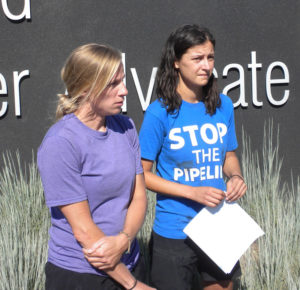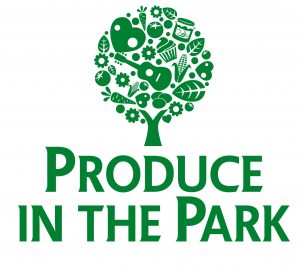CLICK HERE for the latest market quotes from the Iowa Agribusiness Network!
CLICK HERE for the latest market quotes from the Brownfield Ag News Network!
CLICK HERE for the latest market quotes from the Iowa Agribusiness Network!
CLICK HERE for the latest market quotes from the Brownfield Ag News Network!
(Radio Iowa) – The U-S Court of Appeals has upheld the eight-year prison sentence given to a woman in 2021 after she admitted to damaging the Dakota Access Pipeline. Jessica Reznicek pleaded guilty to conspiracy to damage an energy facility after admitting to vandalism in Buena Vista, Mahaska and Wapello County that included taking a blowtorch to the pipeline. Reznicek argued she was motivated by saving the environment, and the district court erred by classifying her actions as terrorism.

Jessica Reznicek and Ruby Montoya in 2017. (RI photo)
The Appeals Court ruling says the district court would have imposed the same sentence without the terrorism enhancement. It says the district court sentencing considered Reznicek’s “laudable, though ultimately misguided, motivations,” as well as her encouragement of others to imitate her crimes, that her vandalism caused “a grave risk to others,” and that her crimes continued over a long stretch of time.
Ruby Montoya admitted to the vandalism along with Reznicek and reached a plea deal with prosecutors. She has been fighting to withdraw her plea and take the case to trial.
(Radio Iowa) – A small percentage of corn and soybean planting remains after a busy week in the fields. The U-S-D-A report shows that 98 percent of the corn crop is in the ground. That’s three days ahead of the five-year average — but eleven days behind last year’s quick pace. Eighty-seven percent of the corn crop has emerged and the condition is rated 86 percent good to excellent. Ninety-four percent of soybeans are planted — which is six days ahead of the five-year average.
Sixty-nine percent of soybeans have emerged, which is one week behind last year but one day ahead of average. The first soybean condition rating showed 82 percent in good or excellent condition. (67% good 15% excellent).
The Friends of Lake Anita hosted their annual Kids Fishing Day program in conjunction with the Iowa free fishing weekend this past Saturday. The event drew a nice crowd of 75 kids registered on the day.
Kids in attendance heard a presentation on fish identification from Iowa DNR Fisheries Technician Mark Boucher. He used some posters to talk about the differences in fish species in Iowa and then brought out some live fish to have the kids put their identifying skills to the test.
Kids then had about an hour to fish and with some bait and tackle provided if needed. After fishing all kids received a prize package and everyone in attendance was treated to a free will hot dog meal from the Friends of Lake Anita.
The City of Atlantic is informing residents that mosquito spraying will begin this week and will continue every week until further notice. Spraying will take place on Thursday and Friday mornings from 4:00 a.m. to 7:00 a.m.
(Radio Iowa) – The Iowa Department of Agriculture has lifted the restrictions on live bird exhibitions. The Ag Department canceled all live bird exhibitions at fairs and other gatherings of birds on March 23rd as the avian influenza outbreak picked up. The Department issued a notice Friday that it has been 30 days since U-S-D-A has confirmed any new bird flu cases — and they were lifting the restrictions. The bird flu has been confirmed at 19 sites across the state — with 15 of those commercial chicken or turkey operations.
It is believed this outbreak was spread by wild birds during their migration. The Ag Department asks bird owners to remain vigilant in their biosecurity practices preventing contact between their birds and wild birds and reporting sick birds or unusual deaths to state and federal officials.
ATLANTIC, IA – Produce in the Park Market Manager Brigham Hoegh reports Thursday’s opening day for the market in the downtown Atlantic City Park, saw record attendance. Increased market attendance is expected to continue throughout the season given the number of vendors, variety of food trucks, and unique weekly themes and attractions. For example, the June 9 market will feature strawberries—and lots of strawberry products—as well as a taco truck and bounce house.
Strawberries will be everywhere at Produce in the Park June 9. Fresh strawberries will be sold by both Bridgewater Farm and Brun Ko Farm, the Guest Chef will be handing out free strawberry pie samples and recipes, and Sue’s Country Garden will be selling strawberry—and strawberry rhubarb—jams, as well as strawberry pastry bars. Kringleman Pastries will be at the park with strawberry kringle and strawberry cupcakes, Atlas Atlantic Cinema will have fresh-squeezed strawberry lemonade, and Matilda Dawn Creations will be selling strawberry-themed greeting cards. Additional strawberry-themed
activities are expected. 
In addition to strawberries, the June 9 farmers market features Zemog’s Cocina taco truck, live music by Sarah Selders, and the Nishna Valley Family YMCA’s bounce houses and more activities for kids. County Conservation, Atlantic Parks and Recreation, Cass County Master Gardeners, and RSVP (Retired and Senior Volunteer Program) will be at the park with information and activities. Senior Life Solutions and Cass County PROSPER are the June 9 “Self-Care Summer” organization.
Products expected at the park on June 9 include early season produce (such as rhubarb, spinach, asparagus, and green onions), lots of local meats (beef, pork, and lamb), farm-fresh eggs, honey, goatmilk soaps, candles, jewelry, wood crafts, plants for home gardens, and more.
Produce in the Park June 9 Summary:
Time: 4:30-6:30 PM
Location: Atlantic City Park (10 W. 7th Street, Atlantic, IA 50022)
Free Live Music: Sarah Selders
Food Truck: Zemog’s Cocina
Theme: Strawberries! Fresh strawberries from Brun Ko Farm and Bridgewater Farm; free samples of
strawberry pie from the Guest Chef; strawberry kringle and cupcakes from the Kringleman; strawberry
jam and strawberry pastry bars from Sue’s Country Garden; strawberry lemonade from Atlantic Atlas
Cinema; strawberry-greeting cards from Matilda Dawn Creations; and more!
Free drawing: 1 dozen farm-fresh eggs from Brun Ko Farm. (Sponsored by the Cass County Local Food
Policy Council.)
Fun for Kids: Bounce house and more activities by Nishna Valley Family YMCA.
Self-Care Summer Organizations: Senior Life Solutions, Cass County PROSPER
Visiting organizations: Cass County Conservation, Atlantic Parks and Recreation, Cass County Master
Gardeners, RSVP (Retired and Senior Volunteer Program)
Payment methods accepted: All vendors accept cash. Many accept credit card and Venmo. All qualifying
food vendors accept SNAP/EBT (also known as food stamps). All fresh produce vendors both accept and
distribute Double Up Food Bucks (coupons given for SNAP/EBT purchases of fresh produce).
Produce in the Park June 2022 farmers markets are sponsored by the Atlantic Community Promotion Commission, the Nishna Valley Family YMCA, Cass County Tourism, Cass Health, First Whitney Bank and Trust, the Atlantic Area Chamber of Commerce, and Deter Motor Co. For updates on Produce in the Park, follow Produce in the Park on Facebook
(www.facebook.com/ProduceInThePark) or Instagram (www.instagram.com/produceintheparkatlanticia/), or visit the Produce in the Park website to sign up for the e-newsletter at www.produceintheparkatlanticiowa.com.
(Radio Iowa) – Iowans can try their hand at fishing this weekend without having to buy a license. Joe Larscheid, the Iowa D-N-R fisheries bureau chief, says it’s a free fishing weekend, so folks can grab their best fishing pole and head for their favorite fishing hole. “There’s a lot of fish close to shore right now. Bluegills and crappies are easy to catch. Large mouth bass are cruising the shoreline,” Larscheid says. “This is a free fishing weekend so any Iowa residents can fish for free and try out fishing and hopefully make it a lifetime pursuit.”
Larscheid says this event, held the first weekend of June, is always popular with those who enjoy spending time along the state’s rivers and lakes. “It was kind of a cold, wet spring so there’s a lot of pent up desire to get out and go fishing,” Larscheid says. “If you don’t have your license yet, this is a good excuse to go out and try fishing again and hopefully buy a license after that.” In addition to free fishing, Larscheid says the weekend will feature fishing clinics and a chance for law enforcement officers to go fishing with kids as part of “Cops and Bobbers.”
“We have a lot of different local organizations that support free fishing clinics. You go to our website, www.iowadnr.gov/Fishing, and just look, there’s a calendar of events,” Larscheid says. “Normally, the rods and reels and baits are provided and there’s a lot of volunteers that help anglers that are not sure how to fish and get started fishing to be successful.”
The free fishing runs today (Friday) through Sunday at hundreds of Iowa lakes and thousands of miles of rivers. You may purchase a fishing license at the county recorder’s office, a sporting goods store or through the DNR.